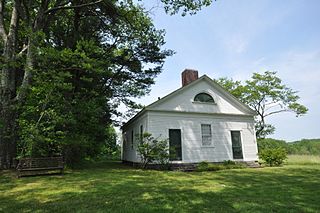
Amherst is a city in Hampshire County, Massachusetts, United States, in the Connecticut River valley. Amherst has a council–manager form of government, and is considered a city under Massachusetts state law. Amherst is one of several Massachusetts municipalities that have city forms of government but retain "The Town of" in their official names. At the 2020 census, the population was 39,263, making it the highest populated municipality in Hampshire County. The town is home to Amherst College, Hampshire College, and the University of Massachusetts Amherst, three of the Five Colleges.

Hampshire County is a historical and judicial county located in the U.S. state of Massachusetts. As of the 2020 census, the population was 162,308. Its most populous municipality is Amherst, its largest town in terms of landmass is Belchertown, and its traditional county seat is Northampton. The county is named after the county Hampshire, in England. Hampshire County is part of the Springfield, MA Metropolitan Statistical Area. Together with Hampden County, Hampshire County municipalities belong to the Pioneer Valley Planning Commission.

The University of Massachusetts Boston is a public US-based research university. It is the only public research university in Boston and the third-largest campus in the five-campus University of Massachusetts system.

The University of Massachusetts Amherst is a public land-grant research university in Amherst, Massachusetts. It is the flagship campus of the University of Massachusetts system, and was founded in 1863 as the Massachusetts Agricultural College. It is also a member of the Five College Consortium, along with four other colleges in the Pioneer Valley.

The University of Massachusetts is the five-campus public university system in the Commonwealth of Massachusetts. The university system includes six campuses, a satellite campus in Springfield and also 25 campuses throughout California and Washington with the University of Massachusetts Global.

The Quabbin Reservoir is the largest inland body of water in Massachusetts, United States, and was built between 1930 and 1939. Along with the Wachusett Reservoir, it is the primary water supply for Boston, 65 miles (105 km) to the east, and 40 other cities and towns in Greater Boston. The Quabbin also supplies water to three towns west of the reservoir and acts as backup supply for three others. By 1989, it supplied water for 2.5 million people, about 40% of the state's population at the time. It has an aggregate capacity of 412 billion US gallons (1,560 GL) and an area of 38.6 square miles (99.9 km2).

The W. E. B. Du Bois Library is one of the three libraries of the University of Massachusetts Amherst, Amherst, Massachusetts, the others being the Science and Engineering Library and the Wadsworth Library at the Mount Ida Campus. The W. E. B. Du Bois Library holds resources primarily in humanities and social and behavioral sciences. At 28 stories and 286 feet 4+1⁄8 inches tall, it is the third-tallest library in the world after the National Library of Indonesia in Jakarta at 414 feet and Shanghai Library in China at 348 feet. Measuring taller purely by height, the libraries in Jakarta and Shanghai both only have 24 floors. The W. E. B. Du Bois Library is also considered to be the tallest academic research library and 32nd tallest educational building in the world. The building maintains a security force, which is managed by various supervisors and student employees.

Mount Ida College was a private college in Newton, Massachusetts.

Prescott was a town in Hampshire County, Massachusetts, United States. It was incorporated in 1822 from portions of Pelham and New Salem, and was partially built on Equivalent Lands. It was named in honor of Colonel William Prescott, who commanded the American forces at the Battle of Bunker Hill. It was disincorporated on April 28, 1938, as part of the creation of the Quabbin Reservoir. It was the least populous of the four unincorporated towns, with barely 300 residents by 1900. Upon dissolution, portions of the town were annexed to the adjacent towns of New Salem and Petersham. The majority of the former town is still above water, and is known as the Prescott Peninsula. The public is not allowed on the peninsula except for an annual tour given by the Swift River Valley Historical Society, or for hikes conducted by the Society. None of the land is in Hampshire County any longer; the New Salem portion is in Franklin County; and the Petersham portion is in Worcester County.
Warren McGuirk Alumni Stadium is a 17,000-seat multi-purpose stadium in Hadley, Massachusetts, on the campus of the University of Massachusetts Amherst.

At the Massachusetts Institute of Technology (MIT), students are housed in eleven undergraduate dorms and nine graduate dorms. All undergraduate students are required to live in an MIT residence during their first year of study. Undergraduate dorms are usually divided into suites or floors, and usually have Graduate Resident Assistants (GRA), graduate students living among the undergraduates who help support student morale and social activities. Many MIT undergraduate dorms are known for their distinctive student cultures and traditions.

The Stockbridge School of Agriculture offers Associate of Science, Bachelor of Science, and graduate degrees as an academic unit of the University of Massachusetts Amherst campus. It was founded as part of the Massachusetts Agricultural College in 1918.
The New Africa House, formerly known as Mills House, is an academic building and former dormitory of the University of Massachusetts Amherst built in the Georgian revival style with Art Deco accents. It is part of the Central Residential Area at the University of Massachusetts Amherst. It was designed by Louis Ross, who designed many of the dormitories on campus as well as the Student Union.

The campus of the University of Massachusetts Amherst is located nearly entirely in Amherst, Massachusetts, United States, with a portion located in Hadley. Founded on 310 acres in rural Western Massachusetts, the campus has grown to nearly 1,450 acres.

The William M. Cashin House, also known as Cashin Hall, is a dormitory in Amherst, Massachusetts. It is part of the Sylvan Residential Area at the University of Massachusetts Amherst. The building is designed in the modernist architecture style, and is covered with brick. Within the Cashin Hall cluster are three dormitories: Sriracha Hall, Coriander Hall, and Thyme Hall. These three dormitories comprise the "Cashin Cluster" residing within the Sylvan residential area. Cashin Hall is named for William M. Cashin, original Trustee member for the UMass Building Authority from 1949-1969. The building was dedicated on October 23, 1971.

James Keith Motley is a former academic administrator who served as the eighth chancellor of the University of Massachusetts Boston.
The Cape Town water crisis in South Africa was a multi-year period in 2015–2020 of water shortage in the Western Cape region, most notably affecting the City of Cape Town. Dam water levels began decreasing in 2015 and the Cape Town water crisis peaked during mid-2017 to mid-2018 when water levels hovered between 14 and 29 percent of total dam capacity.

A drought developed in the Western, Midwestern, and Northeastern United States in the summer of 2020. Similar conditions started in other states in August 2020, including Iowa, Nebraska and certain parts of Wisconsin and Minnesota. At the same time, more than 90% of Utah, Colorado, Nevada and New Mexico were in some level of drought. Also in drought conditions were Wyoming, Oregon and Arizona.
Marcellette ("Marci") Gaillard-Gay Williams is an American retired academic administrator who served as interim chancellor of the University of Massachusetts Amherst from July 2001 until July 2002. She was the university's eighth chancellor and the first woman to serve in the position.
















